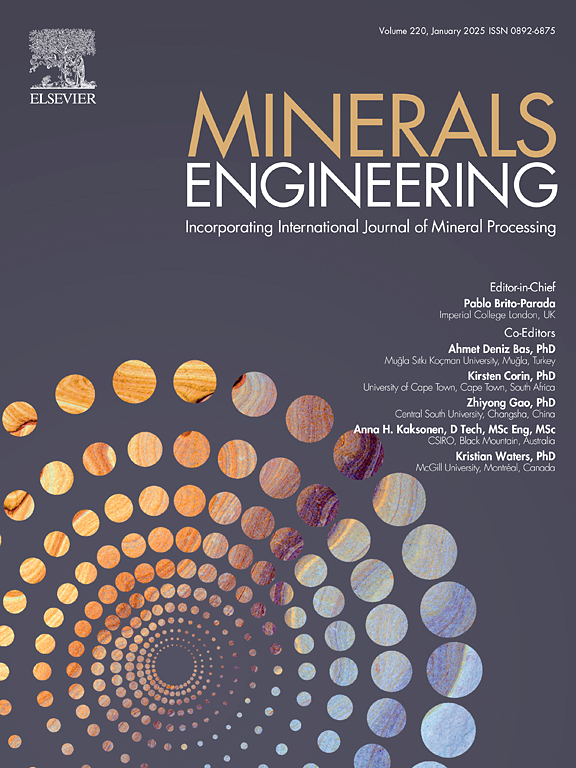Co-TiO2@ZIF-8 光催化降解铝酸钠溶液中的硫代硫酸根离子
IF 4.9
2区 工程技术
Q1 ENGINEERING, CHEMICAL
引用次数: 0
摘要
高硫铝土矿在拜耳法精炼过程中生成的强碱性铝酸钠溶液中含有硫,主要以硫代硫酸根(S2O32-)离子的形式存在,会影响目标产品(氧化铝)的质量。因此,高硫铝土矿的大规模使用受到严重限制,迫切需要铝酸钠溶液的脱硫方法。为了满足这一需求,我们在此采用溶胶-凝胶法和氮气下低温煅烧法制备了金属有机框架(ZIF-8)支撑的掺杂 Co 的 TiO2(Co-TiO2@ZIF-8),并考察了这种复合材料光催化氧化降解铝酸钠溶液中硫代硫酸根离子的能力。Co-TiO2@ZIF-8 保留了 ZIF-8 的大比表面积和丰富的孔隙率,从而减少了 TiO2 颗粒在表面的团聚。Co-TiO2 的负载使 Co-TiO2@ZIF-8 具有介孔结构,从而提高了其吸附能力。与 ZIF-8 相比,Co-TiO2@ZIF-8 具有新的官能团,Zn-C 和 N-Ti-O 键的形成证实了 Co-TiO2 与 ZIF-8 载体的成功结合。因此,Co-TiO2@ZIF-8 对硫代硫酸盐的去除率比空白样品和纯 TiO2(光源 = 氙弧灯,氧化剂 = O3,反应时间 = 60 分钟)分别高出 42% 和 26%。这种高性能主要归功于掺杂 Co 提高了可见光的利用效率,以及光催化剂表面光生电子-空穴对和空穴与溶液相 OH- 离子相互作用形成的羟基自由基。本文章由计算机程序翻译,如有差异,请以英文原文为准。

Degradation of thiosulfate ions in sodium aluminate solution photocatalyzed by Co-TiO2@ZIF-8
The strongly alkaline sodium aluminate solution generated from high-sulfur bauxites during their refinement through the Bayer process contains sulfur, mainly in the form of thiosulfate (S2O32−) ions, which affects the quality of the target product (alumina). Consequently, the large-scale use of high-sulfur bauxites is severely limited, and methods of desulfurizing sodium aluminate solutions are urgently needed. To address this need, we herein prepared metal–organic framework (ZIF-8)-supported Co-doped TiO2 (Co-TiO2@ZIF-8) using a sol–gel method and low-temperature calcination under N2 and examined the ability of this composite to photocatalyze the oxidative degradation of thiosulfate ions in sodium aluminate solutions. Co-TiO2@ZIF-8 retained the large specific surface area and rich porosity of ZIF-8, which reduced the agglomeration of TiO2 particles on the surface. The loading of Co-TiO2 endowed Co-TiO2@ZIF-8 with a mesoporous structure and thus increased its adsorption capacity. Compared with ZIF-8, Co-TiO2@ZIF-8 featured new functional groups, and the formation of Zn–C and N–Ti–O bonds confirmed the successful integration of Co-TiO2 with the ZIF-8 carrier. Consequently, the thiosulfate removal rates by Co-TiO2@ZIF-8 were 42 % and 26 % higher than those observed for the blank sample and pure TiO2 (light source = xenon arc lamp, oxidant = O3, reaction time = 60 min), respectively. This high performance is primarily due to Co doping, which enhanced the efficiency of visible light utilization, and the photogenerated electron–hole pairs on the photocatalyst surface and hydroxyl radicals formed by the interaction of holes with the solution-phase OH− ions.
求助全文
通过发布文献求助,成功后即可免费获取论文全文。
去求助
来源期刊

Minerals Engineering
工程技术-工程:化工
CiteScore
8.70
自引率
18.80%
发文量
519
审稿时长
81 days
期刊介绍:
The purpose of the journal is to provide for the rapid publication of topical papers featuring the latest developments in the allied fields of mineral processing and extractive metallurgy. Its wide ranging coverage of research and practical (operating) topics includes physical separation methods, such as comminution, flotation concentration and dewatering, chemical methods such as bio-, hydro-, and electro-metallurgy, analytical techniques, process control, simulation and instrumentation, and mineralogical aspects of processing. Environmental issues, particularly those pertaining to sustainable development, will also be strongly covered.
 求助内容:
求助内容: 应助结果提醒方式:
应助结果提醒方式:


